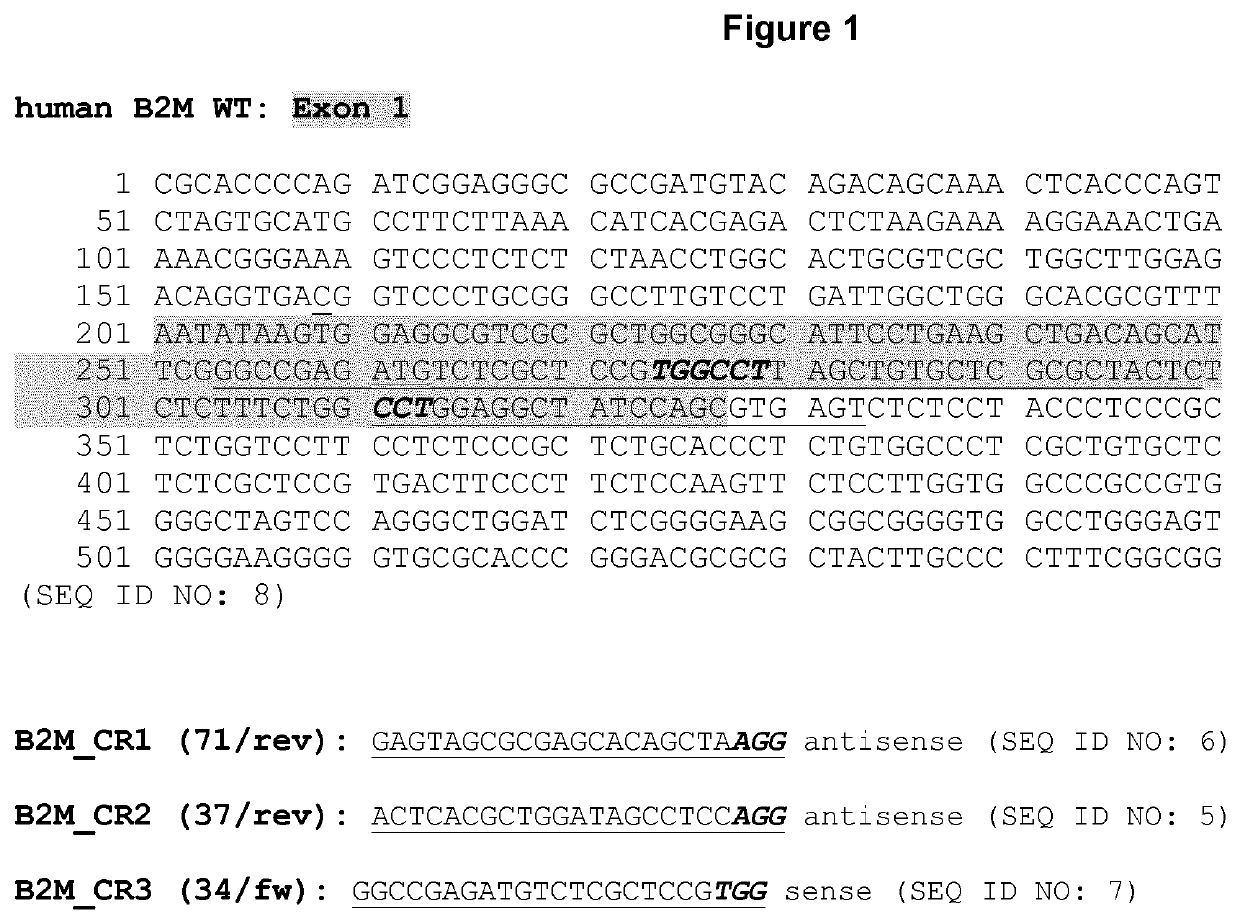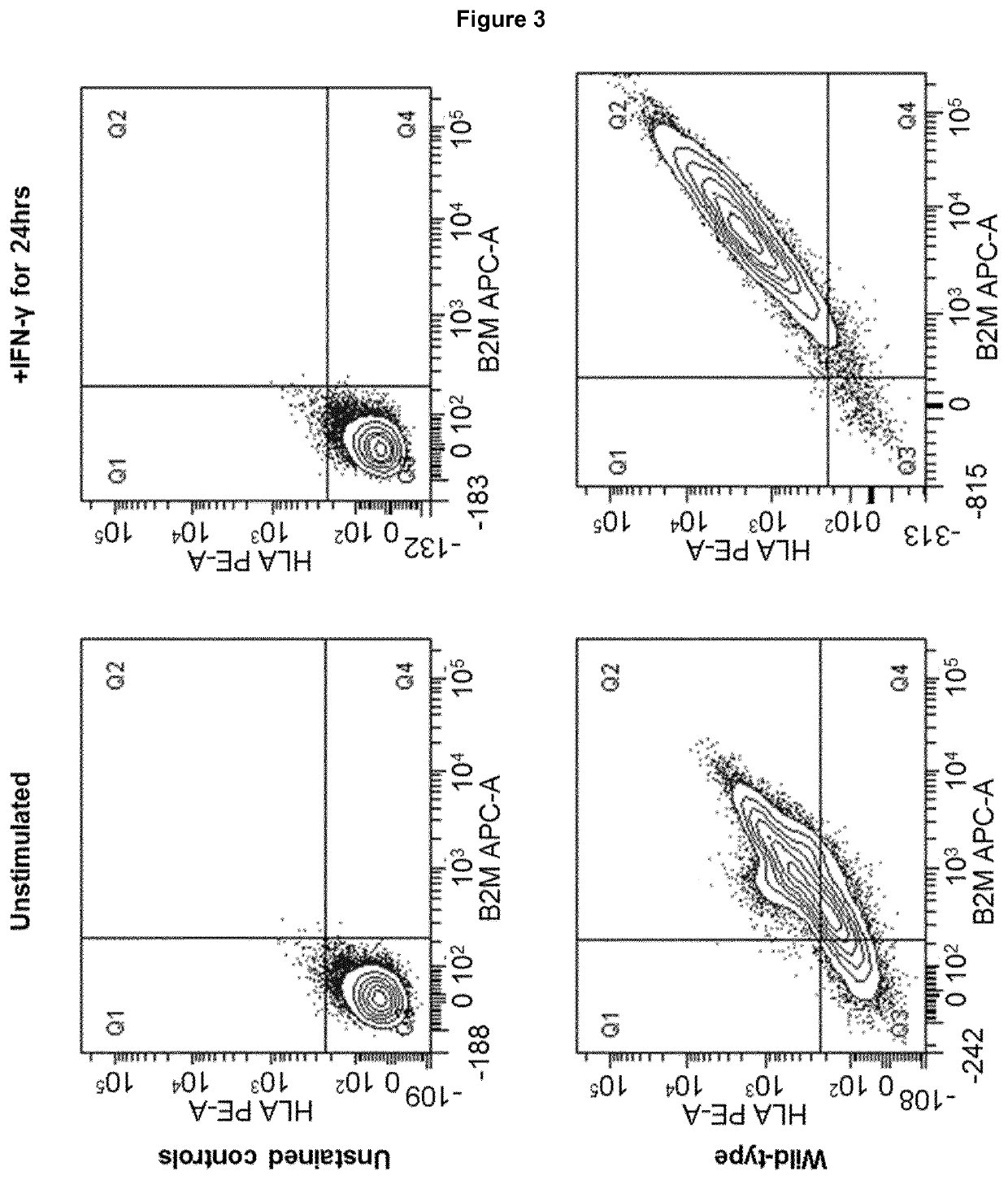Non-immunogenic engineered tissue and methods of producing and using the same
a non-immunogenic, engineered tissue technology, applied in the direction of skeletal/connective tissue cells, microorganisms, genetically modified cells, etc., can solve the problems of transplant rejection, tissue or functional skeletal tissue, and inability to replace dysfunctional organs or tissues,
- Summary
- Abstract
- Description
- Claims
- Application Information
AI Technical Summary
Benefits of technology
Problems solved by technology
Method used
Image
Examples
example 1
n of Pluripotent Stem Cells being Deficient of MHC Class I Molecules and Comprising an Immunomodulatory Protein on their Surface
Knock Out of β2-Microglobulin (B2M)
[0090]Pluripotent stem cell line 50039 was obtained from the NINDS Human Cell and Data Repository. This cell line is also available from Lonza and was characterized in Baghbaderani et al. (2015), Stem Cell Reports, 5:647-6659. Baghbaderani et al. also disclose standard conditions for maintain this cell line. Differing from this, the pluripotent cells were maintained in StemMACS™ iPS-Brew medium. For the provision of an extracellular matrix, CTG Laminin-521 (Biolamina) or Geltrex (Thermo Scientific) was used.
[0091]To disrupt all copies of the B2M gene, the Alt-R® CRISPR / Cas technology of Integrated DNA Technologies was used according to the instructions of the manufacturer. Depending on the sequence of the CRISPR-Cas9 crRNA, the Alt-R Cas9 nuclease is capable of specifically introducing double strand breaks, which may resul...
example 2
dified PSC to Generate Bioengineered Heart Muscle Tissue
[0101]Engineered heart muscle can be generated starting from PSC using the protocol described in WO 2015 / 040142 and Tiburcy et al. (2017), Circulation, 135:1832-1847 as well as WO 2015 / 025030. The pluripotent stem cells, particularly clones 18, 20 and 34, of Example 1 may be used in this example. This protocol comprises the steps of inducing mesoderm differentiation, cardiac differentiation and cardiac maturation as described in WO 2015 / 040142 followed by directed tissue formation in a collagen type I hydrogel as described in WO 2015 / 025030.
[0102]In a first step, the PSC have to be differentiated to cardiomyocytes. This can be done as e.g. described in Tiburcy et al. (2017), Circulation, 135:1832-1847 and originally disclosed in WO 2015 / 040142. The pluripotent stem cells (PSCs) of Example 1 may be plated at 5×104 to 1×105 cells / cm2 on 1:30 Matrigel in phosphate-buffered saline (PBS)-coated plates and cultured in Knockout DMEM, ...
example 3
dified PSC to Generate Bioengineered Heart Muscle Tissue
[0104]The hIPSCs obtained herein (see Example 1) were differentiated into cardiomyocytes (CMs) based on the protocol described above in Example 2 (Tiburcy et al. 2017 as well as WO 2015 / 025030). HLA-E KI hIPSC-derived CMs showed expression of sarcomeric proteins; alpha-actinin and cardiac Troponin T (cTnT) with a high purity of >90% actinin+ cells (FIG. 10A).
[0105]Flow cytometry analysis revealed that WT CMs express B2M and HLA Class I molecules; HLA-B and C, but HLA-E under basal conditions. IFN-γ treatment induced even stronger expression in B2M and HLA-B, C molecules and slightly less HLA-E expression (˜60%). As a negative control, B2M KO CMs showed no HLA expression as expected. HLA-E KI Clones (both Dimer and Trimer) expressed B2M and HLA-E only after IFN-γ treatment, and did not show any other HLA Class I expression. CMs differentiated from HLA-E Trimer hIPSC lines presented slightly higher expression of HLA-E as compared...
PUM
 Login to View More
Login to View More Abstract
Description
Claims
Application Information
 Login to View More
Login to View More - R&D
- Intellectual Property
- Life Sciences
- Materials
- Tech Scout
- Unparalleled Data Quality
- Higher Quality Content
- 60% Fewer Hallucinations
Browse by: Latest US Patents, China's latest patents, Technical Efficacy Thesaurus, Application Domain, Technology Topic, Popular Technical Reports.
© 2025 PatSnap. All rights reserved.Legal|Privacy policy|Modern Slavery Act Transparency Statement|Sitemap|About US| Contact US: help@patsnap.com



